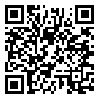Volume 15, Issue 3 (Volume 15, No3 2024)
jdc 2024, 15(3): 189-197 |
Back to browse issues page
Download citation:
BibTeX | RIS | EndNote | Medlars | ProCite | Reference Manager | RefWorks
Send citation to:



BibTeX | RIS | EndNote | Medlars | ProCite | Reference Manager | RefWorks
Send citation to:
Ehsani A, Sadeghi B, Ehsani A, Ansari M S, Razavi Z, Koohian Mohammadabadi M, et al . Epidemiology and treatment of angiokeratoma in Iranian patients: a ten-year study. jdc 2024; 15 (3) :189-197
URL: http://jdc.tums.ac.ir/article-1-5747-en.html
URL: http://jdc.tums.ac.ir/article-1-5747-en.html
Ala Ehsani1 
 , Bahar Sadeghi2
, Bahar Sadeghi2 
 , Amirhoushang Ehsani3
, Amirhoushang Ehsani3 
 , Mahshid-ol- Sadat Ansari2
, Mahshid-ol- Sadat Ansari2 
 , Zahra Razavi2
, Zahra Razavi2 
 , Mina Koohian Mohammadabadi4
, Mina Koohian Mohammadabadi4 
 , Kambiz Kamyab5
, Kambiz Kamyab5 
 , Pedram Nourmohammadpour2
, Pedram Nourmohammadpour2 
 , Mobina Kamalabadi Farahani6
, Mobina Kamalabadi Farahani6 
 , Amirhossein Rahimnia *
, Amirhossein Rahimnia * 
 7
7

 , Bahar Sadeghi2
, Bahar Sadeghi2 
 , Amirhoushang Ehsani3
, Amirhoushang Ehsani3 
 , Mahshid-ol- Sadat Ansari2
, Mahshid-ol- Sadat Ansari2 
 , Zahra Razavi2
, Zahra Razavi2 
 , Mina Koohian Mohammadabadi4
, Mina Koohian Mohammadabadi4 
 , Kambiz Kamyab5
, Kambiz Kamyab5 
 , Pedram Nourmohammadpour2
, Pedram Nourmohammadpour2 
 , Mobina Kamalabadi Farahani6
, Mobina Kamalabadi Farahani6 
 , Amirhossein Rahimnia *
, Amirhossein Rahimnia * 
 7
7
1- Skin Research Center, Shahid Beheshti University of Medical Sciences, Tehran, Iran
2- Department of Dermatology, Tehran University of Medical Sciences, Tehran, Iran
3- Autoimmune Bullous Diseases Research Center, Razi Hospital, Tehran University of Medical Sciences, Tehran, Iran
4- Department of Medicine, Iran University of Medical Sciences, Tehran, Iran
5- Department of Pathology, Tehran University of Medical Sciences, Tehran, Iran
6- Department of Medicine, Tehran University of Medical Sciences, Tehran, Iran
7- Autoimmune Bullous Diseases Research Center, Razi Hospital, Tehran University of Medical Sciences, Tehran, Iran ,rahimnia.amir@gmail.com
2- Department of Dermatology, Tehran University of Medical Sciences, Tehran, Iran
3- Autoimmune Bullous Diseases Research Center, Razi Hospital, Tehran University of Medical Sciences, Tehran, Iran
4- Department of Medicine, Iran University of Medical Sciences, Tehran, Iran
5- Department of Pathology, Tehran University of Medical Sciences, Tehran, Iran
6- Department of Medicine, Tehran University of Medical Sciences, Tehran, Iran
7- Autoimmune Bullous Diseases Research Center, Razi Hospital, Tehran University of Medical Sciences, Tehran, Iran ,
Abstract: (56 Views)
Background and Aim: Angiokeratomas are rare vascular lesions, typically presenting as small red to purple macules or papules on the skin. These lesions are usually benign, though they can undergo changes in thickness and color over time. Certain types of angiokeratomas may also signal underlying metabolic disorders, necessitating careful clinical attention. This study aims to analyze the clinical and demographic features of angiokeratoma in Iranian patients at Razi Dermatology Hospital.
Methods: This descriptive, retrospective cross-sectional study examined 199 patients diagnosed with angiokeratoma between 2013 and 2023. Data on demographics, lesion characteristics (location and size), family history, and treatment methods were collected from medical records and analyzed using SPSS. Both parametric and non-parametric statistical tests were applied to assess associations, with a significance level set at 0.05.
Results: The mean age of patients was 24.75 years, with the second and third decades showing the highest prevalence. Among the patients, 51.3% were male and 48.7% female. Lesions most commonly appeared on the lower extremities (40.7%) and genital area (18.6%). Treatment methods included cryotherapy (68.14%), laser (27.14%), and electrodessication (4.44%), with cryotherapy proving the most effective among them.
Conclusion: This study provides valuable insights into the prevalence, clinical characteristics, and preferred treatment approaches for angiokeratoma in Iranian patients. Broader studies across various centers, along with long-term follow-up, are recommended to further investigate the clinical course, therapeutic outcomes, and potential complications associated with different treatment methods.
Methods: This descriptive, retrospective cross-sectional study examined 199 patients diagnosed with angiokeratoma between 2013 and 2023. Data on demographics, lesion characteristics (location and size), family history, and treatment methods were collected from medical records and analyzed using SPSS. Both parametric and non-parametric statistical tests were applied to assess associations, with a significance level set at 0.05.
Results: The mean age of patients was 24.75 years, with the second and third decades showing the highest prevalence. Among the patients, 51.3% were male and 48.7% female. Lesions most commonly appeared on the lower extremities (40.7%) and genital area (18.6%). Treatment methods included cryotherapy (68.14%), laser (27.14%), and electrodessication (4.44%), with cryotherapy proving the most effective among them.
Conclusion: This study provides valuable insights into the prevalence, clinical characteristics, and preferred treatment approaches for angiokeratoma in Iranian patients. Broader studies across various centers, along with long-term follow-up, are recommended to further investigate the clinical course, therapeutic outcomes, and potential complications associated with different treatment methods.
Type of Study: Research |
Subject:
General
Received: 2024/12/29 | Accepted: 2024/11/5 | Published: 2024/11/5
Received: 2024/12/29 | Accepted: 2024/11/5 | Published: 2024/11/5
Send email to the article author
| Rights and permissions | |
 |
This work is licensed under a Creative Commons Attribution-NonCommercial 4.0 International License. |



